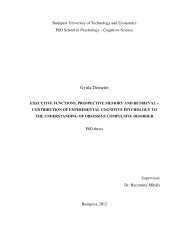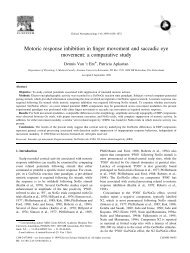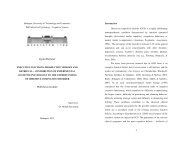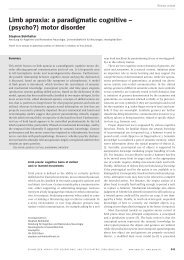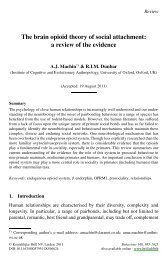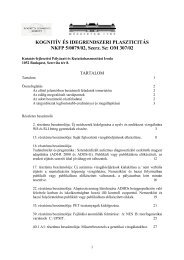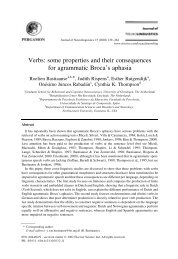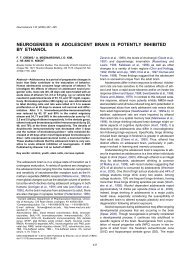Herlitz, Rehnman (2008)
Herlitz, Rehnman (2008)
Herlitz, Rehnman (2008)
Create successful ePaper yourself
Turn your PDF publications into a flip-book with our unique Google optimized e-Paper software.
ears, or pieces of clothing in rapid succession, preventing<br />
the participants from verbalizing the faces (Lewin & <strong>Herlitz</strong>,<br />
2002). It was found that women recognized more faces<br />
than men did, irrespective of whether verbal encoding was<br />
suppressed or not—thus providing no support for the hypothesis<br />
that women use their greater verbal abilities to encode<br />
faces. However, the results also revealed that the female recognition<br />
advantage was magnified for female faces. This tendency<br />
for females to remember faces of their own sex more<br />
accurately than faces of the opposite sex (i.e., ‘‘the own-sex<br />
effect’’) is found across age, so that both young girls and<br />
adult women remember more female faces, irrespective of the<br />
age of the faces (e.g., faces of young girls or adult women) and<br />
across ethnicity (i.e., ethnically familiar or unfamiliar faces). In<br />
contrast, men tend to remember male and female faces equally<br />
well (e.g., <strong>Rehnman</strong> & <strong>Herlitz</strong>, 2006, 2007). Why might this be<br />
the case?<br />
To address this intriguing issue, we created a set of androgynous<br />
faces (see Fig. 3) and showed the same set to three groups of<br />
men and women (<strong>Rehnman</strong>, Lindholm, & <strong>Herlitz</strong>, 2007). The<br />
three groups saw the same group of androgynous faces but received<br />
somewhat different instructions—that they would be<br />
presented with a series of either (a) ‘‘female faces,’’ (b) ‘‘male<br />
faces,’’ or (c) ‘‘faces,’’ and that their task was to remember the<br />
faces for a later recognition task. Interestingly, women who were<br />
told that they should remember female faces remembered more<br />
faces than women who were told to remember male faces or just<br />
faces. By contrast, men performed at similar levels across instructional<br />
conditions. In addition, women remembered more<br />
androgynous faces than men did when they were told to remember<br />
just (gender-unspecified) faces.<br />
We interpret these findings to mean that women allocate more<br />
attention to female than to male faces. Studies on infants have<br />
shown that infant girls devote more attention to faces than infant<br />
boys do (Conellan, Baron-Cohen, Wheelwright, Batki, & Ahluwalia,<br />
2000). Speculatively, the attention infant girls devote to<br />
faces may form the basis of women’s superior face-recognition<br />
ability. Moreover, developmentally, categorization of female<br />
Fig. 3. An example of the androgynous faces used in the <strong>Rehnman</strong>,<br />
Lindholm, & <strong>Herlitz</strong> (2007) study of face recognition.<br />
Sex Differences in Episodic Memory<br />
faces precedes that of male faces for both sexes, possibly as a<br />
result of greater early exposure to female than to male faces<br />
(Ramsey-Rennels & Langlois, 2006). With increasing age, girls<br />
may develop their interest in other females, which also might be<br />
strengthened through their interactions with other women. By<br />
contrast, developing boys may orient themselves toward other<br />
males, losing their early advantage for categorization of female<br />
faces and resulting in an absence of bias.<br />
DEVELOPMENTAL TRENDS AND ENVIRONMENTAL<br />
FACTORS<br />
In research on sex differences, one focus has been on whether the<br />
magnitude of the differences varies across the life span. Explanation<br />
of the differences to some extent rests on whether or<br />
not it does. For example, a change in the magnitude or direction<br />
of sex differences around puberty would suggest that the<br />
biological (e.g., hormonal) changes taking place around<br />
that time are important in explaining the differences. With<br />
regard to sex differences in verbal episodic-memory tasks,<br />
it is clear that there are sex differences in the recall of word<br />
lists favoring girls at a young age (i.e., age 5; d .39) and that<br />
those differences are of similar magnitude in young adults (i.e.,<br />
age 15; d .43; e.g., Kramer et al., 1997), middle-aged adults,<br />
and old adults (d .25; e.g., <strong>Herlitz</strong> et al., 1997). The same<br />
appears to be true for sex differences in face recognition (age 9,<br />
d .47, adults d .53; <strong>Rehnman</strong> & <strong>Herlitz</strong>, 2006, 2007), although<br />
much less research has been conducted in this area.<br />
Thus, data seem to suggest that the major biological changes<br />
associated with development and aging do not influence the<br />
pattern and magnitude of sex differences in these episodicmemory<br />
tasks.<br />
Another important question is whether sex differences in<br />
episodic memory exist throughout the world. Large variations in<br />
the pattern and magnitude of sex differences would suggest that<br />
cultural factors influence the differences to a considerable degree.<br />
To our knowledge, sex differences in episodic memory have<br />
been examined in 23 out of 192 United Nations member states,<br />
and although the bulk of studies come from Europe and North<br />
America, there are a sufficiently large number of studies of<br />
verbal episodic memory conducted in Australia to conclude that<br />
sex differences are present also in this part of the world. Whether<br />
the same pattern of data exists on the African continent and in<br />
South America remains unknown, whereas studies emanating<br />
from Southeast Asia (e.g., Kim & Kang, 1999) seem to indicate a<br />
similar pattern of sex differences in verbal episodic memory as in<br />
Australia, Europe, and North America.<br />
Factors such as education and public exposure may influence<br />
the magnitude, rather than the pattern, of sex differences. This is<br />
illustrated in a study in which we compared the magnitude and<br />
pattern of cognitive sex differences in literate and illiterate older<br />
adults from Bangladesh and Sweden (<strong>Herlitz</strong> & Kabir, 2006).<br />
54 Downloaded from<br />
cdp.sagepub.com by Attila Keresztes on February 25, 2013<br />
Volume 17—Number 1





